While we may quibble about how to pronounce its name, there’s no denying that Vega is one of the most fascinating and useful stars in the heavens.
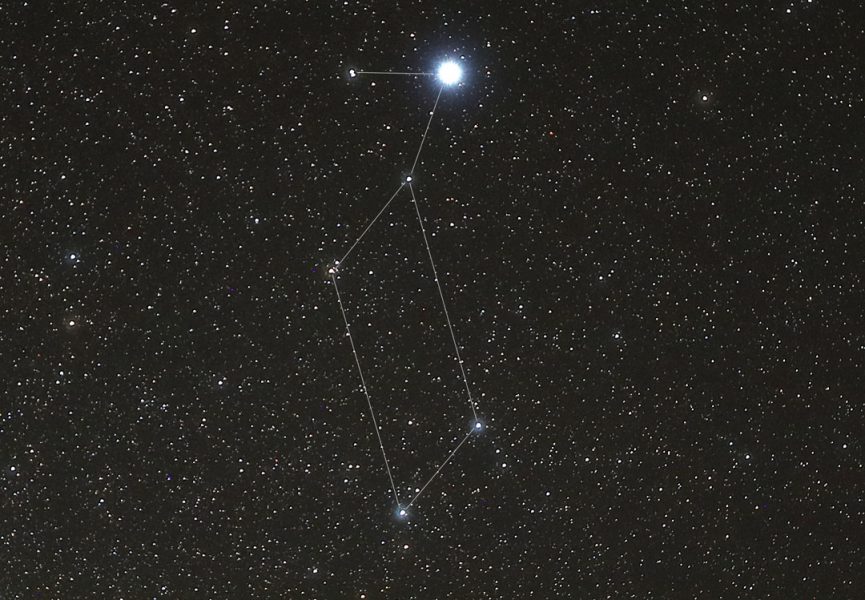
Bob King
Vega, the fifth-brightest nighttime star, beams almost straight overhead early this month and may be the most important luminary in the sky after the Sun. But how exactly do you say its name? Is it VEE-guh or VAY-guh?
In July 2006, Sky & Telescope's Tony Flanders addressed the question:
"In 1941 the American Astronomical Society (AAS) formed a committee of Samuel G. Barton, George A. Davis, Jr., and Daniel J. McHugh to consult with astronomers, educators, Arabic scholars, and planetarium lecturers and come up with a list of preferred pronunciations for common star names and constellations. Their final report, adopted by the AAS, appeared in Sky & Telescope for June 1943, page 12."
They decided that Vega should be pronounced VEE-guh. This made sense because for centuries it had been known as Wega and spoken as WE-guh, which means descending eagle in Arabic. Later, the W evolved into a V, but the pronunciation remained the same: VEE-guh. As a budding amateur astronomer in 1966, I owned an Edmund planisphere that included an instruction manual with a pronunciation guide in line with AAS standards.
Say what?
Yet somewhere along the way Vega became (mostly) VAY-guh, leaving me and my ilk in the minority. Nowadays, the online Merriam-Webster dictionary gives both pronunciations, while the American Heritage Dictionary lists VEE-guh. Recognizing that language evolves, I tell newcomers to the hobby that either is correct.
I have a hunch that the shift to VAY-guh, at least in the U.S., occurred for several reasons. First, the country has a sizable Spanish-speaking population. In Spanish the "e" sound is pronounced "ay" not "ee." Think Las Vegas. In fact, Vega is a common Spanish surname and means "meadow" or "fertile plain." But I also suspect the Chevrolet Vega had something to do with the whole business.
Named for the star and pronounced VAY-guh, the car was a big hit in the early 1970s until owners discovered it was prone to gas tank fires, rapid rusting, and melting engine parts. The rise and fall of the Vega from happy TV commercials to infamy seared its name (and pronunciation) in the public memory. While we're on the topic, in the 1997 movie Contact, Jodie Foster, as Dr. Ellie Arroway, receives a message from sentient beings on a planet around Vega, pronounced VAY-guh (ugh!) throughout the film. To brush up on star names, consult this star and constellation pronunciation guide or listen to this audio version.
However your say it, Vega is a white, brilliant, and radiant star. With a declination of nearly +39°, it shines directly overhead for anyone living at latitude 39° north. A quick look reveals several large cities share this good fortune: Topeka, Kansas; Dover, Delaware; Baltimore, Maryland; Cincinnati, Ohio; and Kansas City, Missouri. From my site at 47° north, it passes south of the zenith but close enough to require some serious neck-twisting at culmination.
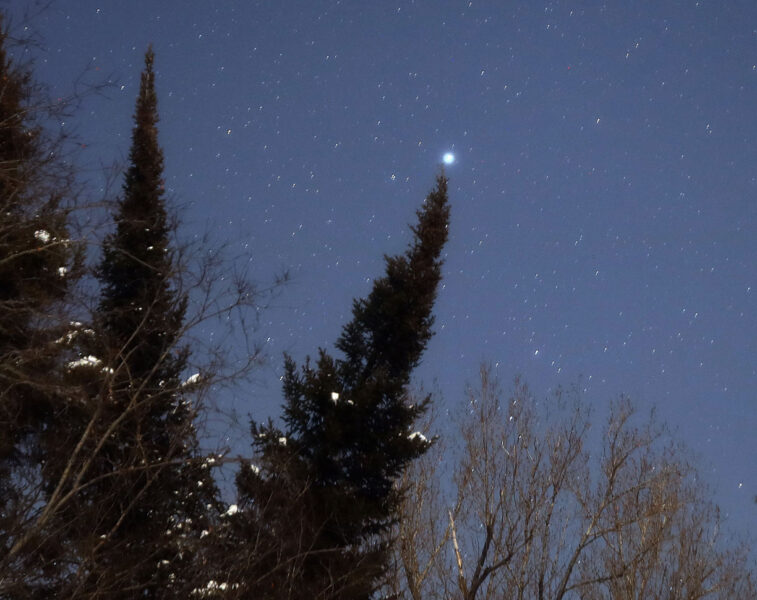
Bob King
For many, Vega is a harbinger of summer in the dead cold of winter, glittering between bare branches in the northeastern sky around 1 a.m. local time in late February. I love seeing it rise during my late-night walks. As a child, I watched it climb over the neighbor's snowy backyard from my bedroom window when I was supposed to be asleep.
Vegan promise
Living in Duluth, Minnesota, where winters can be tenacious, Vega brings hope. It's also inextricably tied to the summer as the brightest star in the expansive Summer Triangle asterism. From my latitude, Vega rises first, followed by Deneb and Altair in that order. The trio frames one of the brightest, thickest segments of the Milky Way. From light-polluted, mid-latitude skies, it may be the only section of Milky Way most people ever get to see.
Come fall, Vega is the first of the trio to tilt to the west. Although its northerly declination keeps the star in view for many months, I hate to see it go. If you live north of latitude 51° Vega never leaves your sight because it's circumpolar and never sets. I wonder if anyone has ever seen Vega at its nadir from London, England, when the star hovers only ½° above due north.
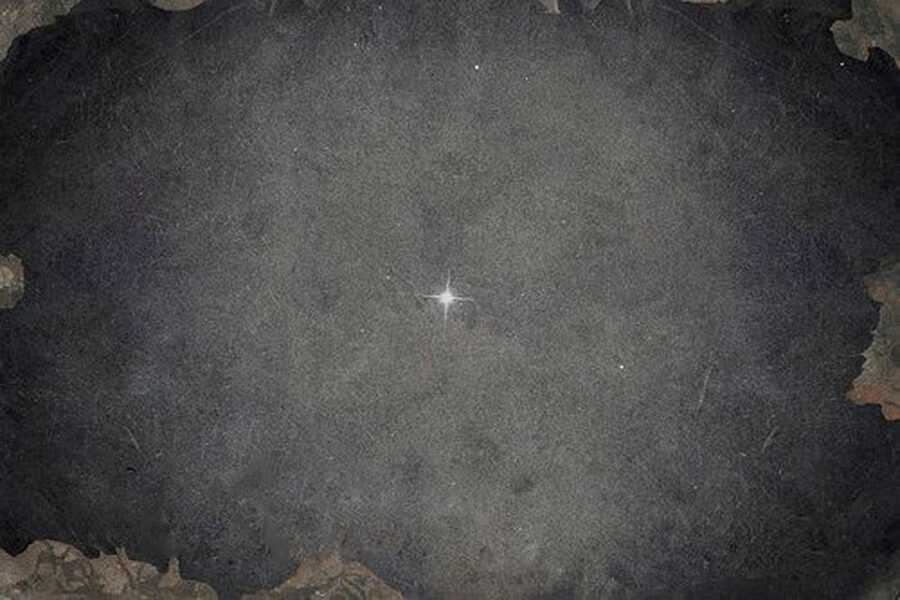
Public domain
On the night of July 16–17, 1850, Vega became the first star after the Sun to have its picture taken. James Adams Whipple and William Bond used the 15-inch refractor at Harvard College Observatory to focus Vega's light onto a sheet of silver-plated copped sensitized with iodine vapors, exposing for about 20 minutes. The anticipation they must have felt watching the image develop over hot mercury fumes must have been just as intense as our wait for the first photos to download from the James Webb Space Telescope.
First again!
In August 1872, amateur astronomer Henry Draper selected Vega as the first nighttime star to have its spectrum photographed. Draper's image revealed the classic absorption lines of hydrogen known as the Balmer series. This step-like sequence of lines results when electrons in a hydrogen atom located at higher energy levels drop down to level 2, the second closest to the nucleus. Each downward drop releases a photon of energy. An electron diving from level 3 to 2 spits out a photon of deep-red light — the familiar H-alpha line. A tumble from 4 to 2 yields H-beta; 5 to 2, H-gamma; and so on.
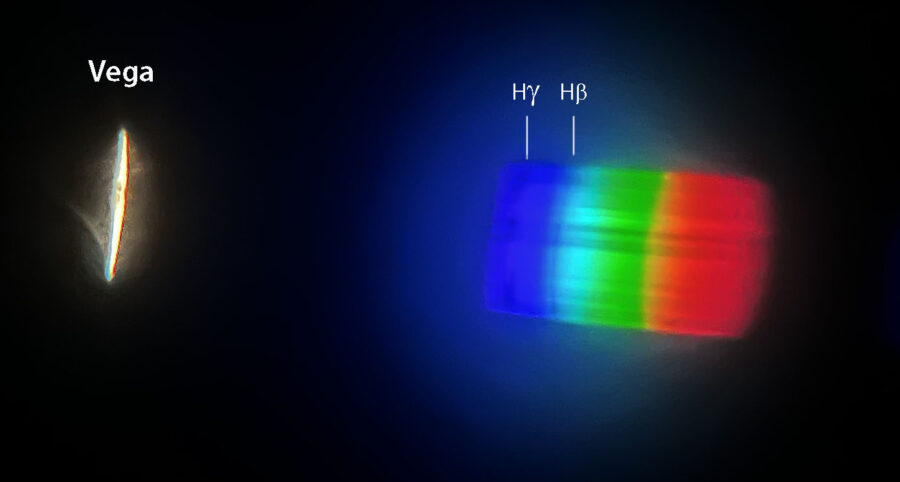
Bob King
Amateur spectroscopists routinely record the Balmer series in Vega and other stars of its spectroscopic class. With a visual instrument, such as the Rainbow Optics Star Spectroscope, the spectral lines are very distinct at the eyepiece. Although that model is no longer available, used spectroscopes show up from time to time on Cloudy Nights. For a modest sum you can also photograph star spectra with your DSLR or mirrorless camera. It's one thing to look at a star and know it's made of hot plasma, but quite another to see hydrogen's "bar code" directly with your own eyes. Vega's prominent lines make it a great place to start.
On the basis of its hydrogen lines, Vega was used to identify and classify similar stars of its type including Sirius, Altair, and Fomalhaut. Based on its "plain vanilla" spectrum and steady light, it's served duty since 1943 as one of the stable standard stars by which others are classified. Vega is a bluish-white, class A0 main sequence star that's 2.1 times as massive as the Sun and about 2.5 times as big located 25 light-years away.
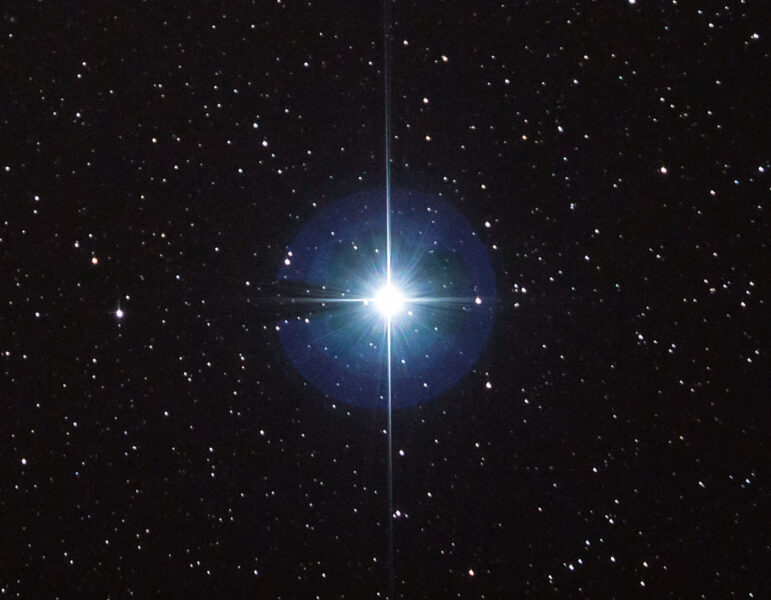
Stephen Rahn, CC 0
Both its proximity and luminosity (40 times greater than the Sun) make it one of the brightest stars in the sky. It shines at magnitude +0.03 and for years was the standard reference for the magnitude-zero point used to calibrate the magnitude scale on photoelectric devices.
Ring 2.0
Like the Sun, Vega burns hydrogen in its core, but because it's hotter and more massive, it will exhaust its energy reserves sooner. At present, the star is about 455 million years old. Vega will leave the main sequence in about 500 million years and bloat into a red giant before expelling its atmosphere and evolving into a white dwarf encircled by a planetary nebula. The next time you observe the Ring Nebula (M57), imagine Vega as its replacement long after the current Ring has expanded and faded beyond recognition.
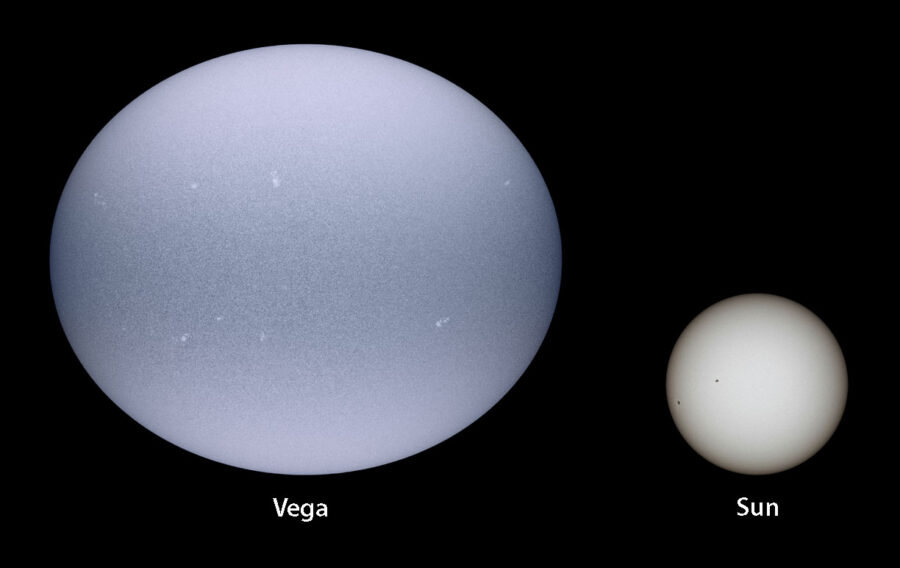
Matus Motlo, CC BY-SA 4.0
Young stars often rotate rapidly, and Vega is no exception, spinning once on its axis every 12.5 hours. Compare that to our sluggard Sun, which takes an average of 27 days. Gaseous objects like stars flex as they spin, so Vega's speedy rotation has stretched it into an egg-like shape called an oblate spheroid. Its equator diameter is 2.82 times that of the Sun, with a polar diameter of 2.36 solar, a difference of 19 percent. From our earthly vantage point we look almost straight down one of its poles.
Vega's shape combined with its rapid spin heats up the polar regions and chills the equatorial zone, making the pole brighter than the equator, a phenomenon known as gravity darkening. The temperature difference is significant: 9,700°C (17,500°F) in the polar regions versus 7,900°C (14,200°F) at the equator.
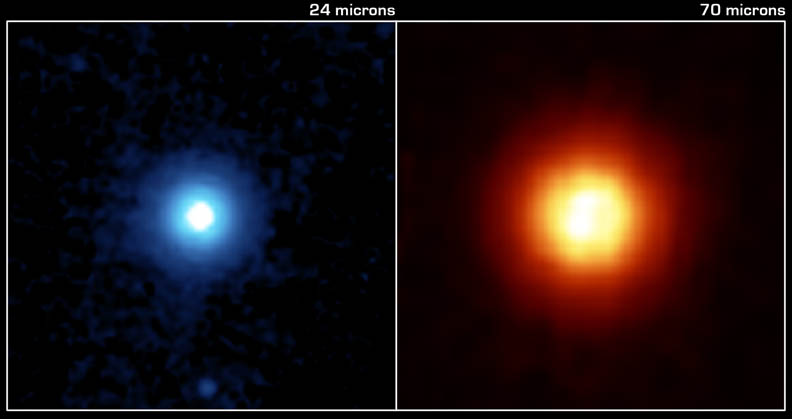
NASA / JPL-Caltech / K. Su
Planet or catastrophe?
While Vega may host an as-yet-unconfirmed Neptune-size planet, we have definitive proof of a dusty debris disk surrounding the star that's likely composed of an amalgam of silicate and carbonaceous grains. The rubbly ring may be home to protoplanets in the rough-and-tumble process of becoming full-fledged planets or the dusty aftermath of a large and recent collision. The Infrared Astronomical Satellite (IRAS) detected an excess of warm, infrared emission around the star in 1983, later photographed by NASA's Spitzer Space Telescope. I should note that the discovery was another feather in Vega's cap — the first star discovered surrounded by a disk of warm dust.
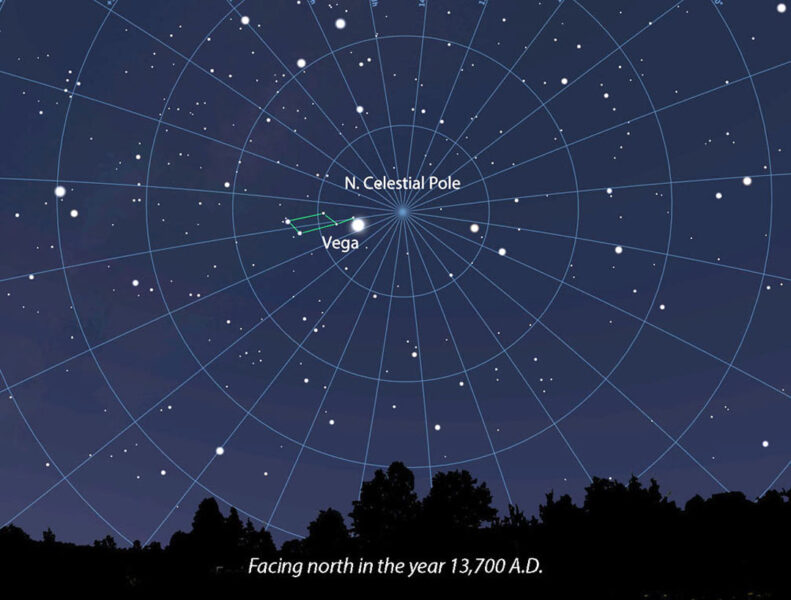
Stellarium
Back in 12,000 BC, Vega was the Pole Star and will be again around AD 13,700. Gravitational forces exerted by the Sun and Moon on Earth's equatorial bulge causes the axis to slowly gyrate with a period of around 26,000 years. Right now, the north polar axis points at Polaris in the Little Dipper, our current North Star. But 12,000 years hence it will aim toward Vega, ensuring that the star's notoriety will persist for millennia. There's more. Ten precession cycles from now it will pass nearest Earth and shine brighter than ever at magnitude –1.4!
 38
38









Comments
Jabberwocky
September 7, 2022 at 5:04 pm
Now I now far more about Vega than I did before--hooray for that! I pronounce it VAY-guh, however, I didn't know that it could be pronounced VEE-ga.
Crouching over mercury fumes in the developing room? XD. I wonder if they did feel similar to us with the Webb about that.
You must be logged in to post a comment.
Bob KingPost Author
September 8, 2022 at 12:25 am
Jabberwocky,
Yes! While we undoubtedly shared the same anticipation as the astronomers of the early photographic era, at least we didn't have breathe hazardous fumes while doing so!
You must be logged in to post a comment.
Jabberwocky
September 8, 2022 at 9:30 am
Bob King,
Ha! Just think how far we've come from film cameras to digital cameras to stuff that Webb uses!
You must be logged in to post a comment.
Bob KingPost Author
September 8, 2022 at 10:30 am
Jabberywocky,
Almost like going from fire to nuclear.
You must be logged in to post a comment.
felis_sapiens25
September 16, 2022 at 1:55 pm
Vega is my home
You must be logged in to post a comment.
Ann of Sweden
November 20, 2022 at 2:15 pm
Vega is one of my absolute favorite stars. I agree that it looks white to the eye. But I insist that it looks quite blue through a telescope! I once showed Vega to a lot of people through a 14 inch telescope, and they all agreed that it looked blue to them.
It actually pains me to hear Vega being described as "white"!
You must be logged in to post a comment.
Bob KingPost Author
November 20, 2022 at 4:01 pm
Hi Ann,
You make a good point. I think I've seen a bit of blue in it as well. I'm not sure whether that's an optical issue or something in how the human eye perceives intense, white light.
You must be logged in to post a comment.
Anthony-Mallama
September 7, 2022 at 5:56 pm
Bob,
Vega was the magnitude zero reference for years, as you mentioned. However, the star is now thought to be a delta Scuti variable with an amplitude of about +/-0.03 magnitudes. So, it was not a very good standard after all.
You must be logged in to post a comment.
Bob KingPost Author
September 8, 2022 at 12:22 am
Hi Anthony,
Thanks for writing. You're correct! So you know, I was aware of its slight variability. That's the reason I wrote "was for years" (note past tense) in the description of the zero point. Since the discovery of its variability, a different type of standard is now in use.
You must be logged in to post a comment.
Anthony-Mallama
September 8, 2022 at 8:40 am
Bob,
I was certain that you knew about the variability but I thought others might find it interesting.
You must be logged in to post a comment.
Bob KingPost Author
September 8, 2022 at 10:30 am
Anthony,
Very glad you brought it up. I think I would have (maybe should have) but was concerned about getting too far off track. So thanks!
You must be logged in to post a comment.
[email protected]
September 8, 2022 at 7:16 am
Great article, thank you.
For me it's VAY-guh, as I think would be for lots in my generation, I was born 84 so I was a 90's child and we had SEGA, I can still hear the opening sound clip you get turning on the console, SAY-GUH!
You must be logged in to post a comment.
Bob KingPost Author
September 8, 2022 at 10:29 am
Hi Ricky,
Thanks! And thank you for sharing your comment. I almost never VEE-guh these days. I feel like a lone cowboy 😉
You must be logged in to post a comment.
Malcolm-McClintick
September 8, 2022 at 3:03 pm
In the fall of 1962 I was taking astronomy in college and my professor, an older guy, always pronounced it VAY-guh.
You must be logged in to post a comment.
Bob KingPost Author
September 9, 2022 at 4:08 pm
Malcolm,
Even that far back? Very interesting.
You must be logged in to post a comment.
Stefan
September 9, 2022 at 4:03 pm
As per general scientific terms, my personal opinion is that all denominations should be pronounced as Latin and according to Latin grammar so as to never have ridiculous issues.
You must be logged in to post a comment.
Bob KingPost Author
September 9, 2022 at 4:09 pm
Hi Stefan,
That said, then it would be VEE-guh, correct?
You must be logged in to post a comment.
relh
September 9, 2022 at 6:09 pm
In Latin, it would probably be Way-gah. I still prefer the questionable pronunciation VAY-guh, as I have for the past 70+ years.
You must be logged in to post a comment.
Bob KingPost Author
September 10, 2022 at 1:02 am
Thank you, relh, but given that the word is Arabic in derivation, would Latin really be the right choice?
You must be logged in to post a comment.
relh
September 11, 2022 at 10:22 am
Agreed, Bob. I was just commenting on Stefan's observation about Latin grammar. In any case, language evolves in ways that lead to initial controversies that usually fade away as people adopt a newer style. Although VEE-gah is probably closer to the 'original' pronunciation, I am guessing that VAY-gah will continue to be the dominate pronunciation.
You must be logged in to post a comment.
Bob KingPost Author
September 11, 2022 at 1:45 pm
Relh,
True all of that. Thank you. I've always been amazed at how much language is like biological evolution with its many twists, turns and variations. A veritable living thing.
You must be logged in to post a comment.
Aberescu
September 15, 2022 at 3:54 am
In Latin would be VEGA, as it's written, with a pronunciation very close to "beggar", V replacing B, and no "r".
You must be logged in to post a comment.
[email protected]
September 9, 2022 at 5:00 pm
Hi, lovely article and am I right it is part of the summer triangle? I always like observing beautiful stars on a dark clear night with binoculars and Vee-gah and Capella are my two favourites. I have always pronounced it as Vee-gah.
You must be logged in to post a comment.
Bob KingPost Author
September 10, 2022 at 1:03 am
Hi Jason,
You're the first to write in to use VEE-guh 🙂 Yes, Vega is the brightest star in the Summer Triangle and the first to rise of the trio from mid-northern latitudes.
You must be logged in to post a comment.
LadyCVN
September 10, 2022 at 5:58 am
Greetings Bob,
I thoroughly enjoyed your article. I was not aware of the Vee-ga pronunciation before. Stargazing has been a hobby since I was a young child. I've taught my grandchildren how to find the Summer Triangle using Vega as a starting point. They enjoy looking at planets and stars through binoculars and my 80mm telescope. Thank you for sharing these insights that I can pass on to them.
You must be logged in to post a comment.
Bob KingPost Author
September 10, 2022 at 10:24 am
Dear LadyCVN,
Thank you! And it makes me happy to know you're sharing your enjoyment of the stars with your grandchildren. They will be grateful.
You must be logged in to post a comment.
AndrewMyl
September 10, 2022 at 10:15 am
Hi Bob,
I look forward to your articles. You always provide new perspectives to celestial objects i take for granted. Vega will never be same again for me. Thank you.
You must be logged in to post a comment.
Bob KingPost Author
September 10, 2022 at 10:21 am
Hi Andrew,
That's really kind of you to say. Thank you.
You must be logged in to post a comment.
Tony Flanders
September 10, 2022 at 9:35 pm
I actually don't think that the AAS report settled anything; like many bureaucratic attempts at standardization, the recommended pronunciations never really "took." Moreover, I'm sure that the pronounciation as Vay-guh is at least as old as Vee-guh, and likely much older.
If you read through the article in question you will see that the principle was to pronounce all the star names as though they were English. There are two basic problems with that idea. Most obviously, English spelling/pronunciation is famously irregular and unpredictable.
More to the point, most star names look foreign, not English, so it makes sense to pronounce them as though they were foreign -- which to a large extent, means as they would be pronounced in Latin. That's because when European languages started to be written in the Middle Ages they were written with the Roman alphabet, using the sounds associated with those letters in Latin. As far as I know, English is the only language where a single "e" can be pronounced as in the first syllable of Peter. In most other languages it's pronounced somewhere between the English vowels "eh" and "ay."
Likewise, when medieval writers transliterated Arabic astronomical terminology into Roman letters they did so using the Latin pronunciation system of their day.
So to me, the obvious and natural way to pronounce Vega is Vay-guh. Not that I have any problem with Vee-guh, mind you. As I remember, S&T editors split about 50-50 on this subject.
English pronunciation is an outlier because the pronunciation of all the vowels shifted dramatically during the period when English spelling was being standardized. That's why it's impossible to guess accurately how any given English word should be pronounced if you've never heard it before. Spanish is just the opposite; it's 100% phonetic.
You must be logged in to post a comment.
Bob KingPost Author
September 11, 2022 at 1:31 pm
Hi Tony,
Great to have you weigh in here. I think you nailed it with one statement: "English spelling/pronunciation is famously irregular and unpredictable." The AAS group wasn't the only one that tried to establish a standard for English speakers. Earlier in 1936, one H.B. Rumrill published a "Star Names Pronunciation Guide" in this ASP paper (https://articles.adsabs.harvard.edu/cgi-bin/nph-iarticle_query?1936PASP...48..139R&defaultprint=YES&filetype=.pdf). His guide was not specifically for English speakers, simply an attempt to create a standard. One of his sources was the venerable R.H. Allen's "Star Names and Their Meanings." Like the AAS report, he also pronounced Vega as VEE-guh. And the constellation Vela was VEE-la.
Speaking of which, it seems strange that while VEE-la is the common pronunciation today, that's not true for Vega. Likewise, everyone says VEE-nus and not VAY-nus and VEE-gan and not VAH-gun. We do indeed have a rather unmoored language.
You must be logged in to post a comment.
StanR
September 11, 2022 at 3:14 am
So, if there is intelligent life there, they would be Vegans I presume 🙂
You must be logged in to post a comment.
Bob KingPost Author
September 11, 2022 at 1:36 pm
Hi Stan,
I love that 🙂 One wonders if the vegans among us don't capitalize the word so as not arouse suspicion of their extraterrestrial origin. PS. Nothing again vegans, of course!
You must be logged in to post a comment.
AccidentalAstronomer
September 11, 2022 at 3:41 am
Bob, another informative article! Thank you.
As an additional bit of trivia, Mercury was also used in the fur industry to recover beaver felt from pelts in order to press hats in the 17th and 18th century. This is where the expression "mad as a hatter" came from because of the damage caused to the brain by prolonged exposure to the element.
I wonder how many early photographers suffered similar mental incapacity in their craft?
Being new to astronomy, I am very open to correction when it comes to proper pronunciation and as was pointed out the car probably affected how I initially pronounced Vega.
You must be logged in to post a comment.
Bob KingPost Author
September 11, 2022 at 1:42 pm
Hi Robin,
Thanks for that bit of history. I suspect you're right that early photographers may have suffered the same. Imagine standing over hot mercury fuming at a temperature of 50-90°C. Things like this always make me wonder what we take for granted doing now that will appall our descendants.
You must be logged in to post a comment.
Frankeinstein
September 11, 2022 at 2:06 pm
Hi Bob,
Thanks for a great article. Wondering though, if we’re looking almost straight down one of its poles, how do we know it’s an oblate spheroid? And that image showing equatorial darkening and star spots must surely be an artist’s rendering.
You must be logged in to post a comment.
Bob KingPost Author
September 11, 2022 at 2:37 pm
Hi fs,
Yes, it's a rendering for sure. You may have missed that in the caption, where I called it an "artist's concept." One reason we know Vega is an oblate spheroid is because its rapid rotation must necessarily make the star bulge at the equator compared to the poles. As proof, astronomers have made detailed interferometer measurements that reveal its egg-like shape and the difference in polar vs. equatorial diameter. Gravity darkening in rapid rotators like Vega cools and darkens the equatorial regions and brightens the poles. We know we're looking down one of the poles because that's where we see Vega brightest and hottest. I hope this answers your question.
You must be logged in to post a comment.
Frankeinstein
September 11, 2022 at 3:06 pm
Thanks Bob, I did miss that in the caption.
Funny story about Chevrolet’s naming of car models. Much mirth was made of the Chevy Nova, “no go” in Spanish.
You must be logged in to post a comment.
OwlEye
September 18, 2022 at 7:04 pm
Hi Bob,
I have enjoyed this star for over 50 years, and whenever Vega is approaching its meridian passage near the end of evening twilight, I know that it's close to Labor Day and the beginning of a new school year. As to its pronunciation, I would quote the character of Shawn Spencer from the TV show Psych, whenever an issue like this arose: "I've heard it both ways." I have always preferred VEE-guh, for the same reason you sited regarding Vela and Vegan, and to disassociate it from the car. However we prefer to pronounce Vega, at least we all know that it is one beautiful star, and is truly at the center of everything - just as you titled this article - when it reaches the meridian, for then it is also near the zenith as well for mid-northern latitudes.
Vega was the very first star that the late, great Leslie Peltier identified as it rose, " just above the plum tree blooming by the well," (quote from Starlight Nights) from his family's farm on a clear evening way back in the spring of 1915.
We also know that when we use the word Vega in an astronomical context, that we are talking about the brightest star in the constellation of Lyra the Lyre. Is Lyra pronounced LYE-ruh, or LEAR-uh? Oh, no . . . 😉 .
You must be logged in to post a comment.
You must be logged in to post a comment.